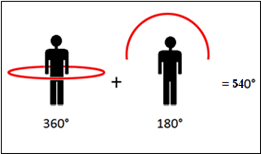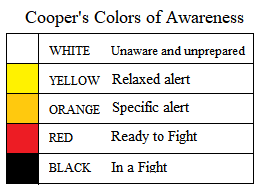Basic Training for Church Safety & Security

An article based on the Safety Member Certification training module "Safety Team Fundamentals" and the Church Security Guide articles "Introduction to Church Safety and Security" and "Church Safety Team Basics."[1][2][3][4]
From the Bible
All scripture is given by inspiration of God, and is profitable for doctrine, for reproof, for correction, for instruction in righteousness (2 Timothy 3:16).
Apply thine heart unto instruction, and thine ears to the words of knowledge (Proverbs 23:12).
Introduction
In many workplaces, reminders are posted about the basics of the business. Oh yes, there are employees who know and follow the basics to the "T." However, there are some things which are forgotten or not always followed by some or several on the team, hence the reminders. Then, there may be some items in the basics which are tweaked, so all employees need to be made aware of the changes.
Some professions, such as teaching and healthcare, require continuing education to maintain certification. Sometimes this includes a brief review of the basics, at least at the beginning of a course.
Church safety & security is no exception to reminders and continued education. Some of us (maybe most?) need reminders lest we miss something we should know. Certification through the Safety Member Certification program is for two years, then recertification is required. Besides the obvious refreshing of what has been learned, this includes new information (such as changes to laws and regulations), techniques, and technology.
On the Web
KTLV, Tyler, Texas, February 16, 2024 - The February 11, 2024 fatal shooting at the Lakewood Church in Houston put leaders and security teams at other churches on high alert. The concern was not the threat of a hostile group, but that it may trigger other mentally disturbed persons. The security director of a church in Tyler, Texas, said that his team was ready. They were already trained in verbal de-escalation and dealing with the mentally ill.[5]
Charleston, South Carolina, March 16, 2024 - The Charleston Atlantic Presbytery and Presbyterian Disaster Assistance conducted training in church safety and security on March 16, 2024. The classes, held at a local church, covered several areas of safety/security, including risks of armed intruders and hate groups, roles of greeters and ushers, survival training (ALICE), threat assessments, Stop the Bleed basics, and safety planning.[6]
Texas Department of Public Safety - Private Security Bureau, Austin, Texas - In a Texas Defense Force Security bulletin, this office in the Texas Department of Public Safety stressed the importance of training to churches: "Church security training is an indispensable aspect of protecting congregations and ensuring a safe worship environment."[7]
Risk Strategy Group, Stephenvillle, Texas - In an insights article, Cody Martin promotes including persons other than members of the Safety Team in safety & security training: "To further enhance security at the church, it's vital to educate staff and congregation members on awareness communication and the appropriate actions to take during different situations." He also stresses "regular and comprehensive training" of the safety team as necessary to protect the congregation.[8]
The Christian and Missionary Alliance, Reynoldsburg, Ohio - CMA leaders stress training a broad spectrum of those working in a church. Their bulletin on church safety and security says it "involves everyone in public leadership" from pastors to parking attendants. Training for their roles includes all of these, especially members of safety teams.[9]
From the Ground Up
Periodic review of the essentials (basics) of any job or position is needed to ensure that the person does not lose touch with the foundation. If a kite string is not held onto (or breaks), the kite will come down. If the tether on a balloon is let go or breaks, the balloon will drift off to who-knows-where. We cannot afford to forget what we are here for and what the basics of the job are.
This is not a complete presentation of all the basics of church safety and security, but an outline. You can learn more from the source articles and the Safety Member Certification training module.[10][1]
Why We Have a Safety Team
There are several potential threats to the safety and health of those who attend (members and visitors), to those who work at the church, and to the church's property. The most common threats are medical incidents and accidental injuries. Other common threats are fire, severe weather, and theft. A threat more common than many want to admit is abuse of our children. Of course the headline grabbers are disruptive behavior and violence. Added to these are the legal threats, both criminal and civil, especially from use of force, citizen's arrest, injuries, and sexual abuse of children.
The purpose of a church safety ministry is to meet these threats both proactively and reactively.
Organizational Basics
A basic feature of orientation to any organization is the purpose and structure of the organization. It explains, "Who we are," "What we do," and "Who's who."
"Who we are" and "What we do"
The members of a church safety & security ministry are the sheepdogs of the flock. Our mission is to protect the sheep (church members and attendees).
"Who's who"
A church safety ministry has three levels: Church Safety Committee, Church Safety Director, and Church Safety Team.
The governing body of a church safety ministry is the Church Safety Committee. It reports to the congregation's governing body and determines the policies and sets the budget of the safety ministry.
The Church Safety Director reports to the Safety Committee. He or she sets procedures for fulfilling the policies. The Director selects members of the Safety Team, and manages it by setting their schedule, guiding them, training them, and holding them accountable.
The safety director works with other ministries in the church on their safety concerns. Examples are cash security in the office, child safety in the children's department, and training ushers and greeters to be the eyes and ears of the church.
The director uses the budget to procure equipment and supplies for the team. He or she may also have to write a report for the church's business meeting.
The Church Safety Team is the "boots on the ground." They patrol the premises, watch the people, are alert for any safety needs, defuse tense situations, and respond to medical emergencies, violent intruders, and other threats. They direct evacuations and in-house sheltering. They also address unsafe situations, such as a tripping or slipping hazard.
Qualifications
Members of a Church Safety Ministry are deacons. As such, they should meet the biblical qualifications for deacons (1 Timothy 3:2, 8-9):
- Respectable
- Faithful to spouse
- Self-controlled
- Sincere (not double-tongued)
- Not addicted to alcohol (no substance abuse)
- Not greedy or dishonest
- Faithful believer
- Have a clear conscience
Additionally, Church Safety Team members must be:
- Members of the church and/or regular attendees (denominations differ on their definitions of membership)
- Able physically to complete assigned tasks
- Able to show good character, integrity, and honesty
- Have no disqualifying criminal convictions
Ethics
Ethics (what is honest and right) is expressed in one's conduct. A church safety team member must act ethically in the following ways (the seven Be's):
- Be humble (honor others above yourself).
- Be respectful (respect everyone, regardless of social status).
- Be diligent (perform all duties completely, correctly, and on time).
- Be exemplary (a good example for others).
- Be faithful (true to your word and to your commitments).
- Be wise.
- Be discrete (keep confidential information confidential).
Priorities
As members of the team there are priorities (things that should not be neglected):
- Attend church services
- Spend time with families
- Participate in training
- Serve during services
- Serve at large events
These priorities relate to your spiritual life, your closest relationships, your effectiveness as a safety team member, and fairness to all the team members. Notice the balance between #1 and #4.
Basic Duties
There are a few basic duties, which include other tasks:
- Serve where posted (assigned), such as the sanctuary, the vestibule, certain entrances, children's department, the parking lot, etc.
- Go on patrols, inside and/or outside.
- Respond to emergencies.
- Be ready to back up another team member.
- Enhance walking safety in bad weather:
- Excessive rain,
- Snow,
- Ice.
- Clean up/remove hazards inside and outside. Report what can't be cleaned up/removed.
- Report suspicious objects, persons, or activities.
- Protect threatened persons, guard (escort) offerings to the counting room, etc.
- Maintain required logs.
Situational Awareness

Awareness and watchfulness are essential to safety and security. Situational awareness is being aware of one’s surroundings. It is a key component of personal self-defense. To describe it, picture yourself standing in the middle of a dome. Your awareness extends 360º around you on the horizontal plane. It also covers you 180º over your head front-to-back and side-to-side. If you are on an upper level, this extends to the level below. Hear Kris explain this on a Church Security Roll Call videocast.[11]
Cooper’s Color Code of Awareness

five levels of awareness from White (unaware) to Black (in a fight). It would be too stressful to always be in Red (ready to fight), but when on duty in church safety, we should be at Yellow (relaxed awareness). If something raises suspicions, then we go to level Orange (specific alert). If you are engaging an active shooter, evacuating people from a fire, or herding them to the tornado shelter with a sound like a train outside, that’s level Black.
Communications
Communication is a key to coordination. Important at all times, communication is critical in an emergency. Modes of communication can be face-to-face, written, public announcement, phone, and radio. In each of these modes, the message must be clear. Unless this is an ethnic church with a different dominant language, use plain English so you can be plainly understood (apply the principle of plain understanding to whatever language is used). For communication within the team, use commonly-understood phrases. Here is a listing from the training course:
- "Go ahead," = "Send your message."
- "Copy," = "The message was received and understood."
- "Say again" = "Retransmit your message." The message wasn't heard clearly by you.
- "Stand by" = "I heard your message but please wait."
- "Affirmative" or "Yes" = "Yes."
- "Negative" or "No" = "No."
- "Do you copy?" = "Do you understand?"
- "Unreadable" = You can't understand the person who transmitted the message (i.e. you don't know what was said because the message was garbled due to a technological problem).
- "Disregard" = "Don't pay any attention to the last message."
Radio Codes
Most of us have heard radio codes used by emergency services and military personnel in movies and TV shows. We may have heard codes used on public address systems while we were in a store. Church safety and security also has a set of codes (sorry, but 10-4 is not one of them):
- Code Red: fire emergency.
- Code Blue: a medical emergency.
- Code Pink: a missing or lost child.
- Code Orange: an actively disruptive or combative person.
- Code Yellow: a suspicious person.
- Code Green: a cash or offerings escort.
- 911: an enhancement code meaning respond quickly and call local law enforcement. (In using this code, you would first give the other code: "Code Orange 911" would be an example.)
Courtesy must be used with the two-way radios. No small talk or joking. Don't interrupt when someone is talking. Make it brief. Answer when called.
Use earpieces with the radios. This keeps a message from disturbing a meeting you are in. It also keeps the messages confidential. With the earpiece in one ear, you can listen to what's around you with the other.
On Patrol
We may have security cameras in place around the church campus, but we still need people on patrol. There are some things which may not show on the monitor screen. Patrolling in person is also a deterrent to criminals. Most of them want to avoid detection and being caught. It spoils their game. We can spell out three kinds of patrols: inside, exterior of the building, campus. Keep patrol times unpredictable. Sometimes patrol in the reverse direction or double back. One thing a would-be culprit watching the church might learn is that a safety team member can show up at any time.
Inside Patrol - Check every unused room to see if it is unoccupied. Check closets, store rooms, and utility rooms. Look for suspicious items. Look at the doors and windows for signs of tampering or attempted forced entry. See that hallways are not blocked, no items left on stairs, and no safety hazards.
Exterior Patrol - Go around the building on the outside. Check for fire hazards and debris or objects that can be used for forced entry or vandalism. Check all the doors and ground-floor windows. Check walkways for pedestrian hazards.
Campus Patrol - Check the grounds away from the main building: the perimeter, shrubbery (possible hiding places), out buildings (such as the yard maintenance shed or a garage), playground equipment, the parking lot, etc.
For more on patrolling, listen to Kris on the Church Security Roll Call videocast.[12]
More to Learn
There are more details in the Safety Member Certification training module "Safety Team Fundamentals" and the Church Security Guide articles.
Conclusion
Some basics are easy to forget or overlook. Refreshing our knowledge of the basics every two years helps keep them fresh in our minds. We can also learn of new material and changes to the basics.
Training Resources
Sheepdog Church Security (SCDS) has a mission of training church safety & security ministry members in keeping their congregations safe and secure. SDCS training resources include the Safety Member Certification program, weekly articles, Church Security Guide articles, the Safety Director Toolkit, and the Safety Ministry Training Sheepdog Articles.[13]
Certification training is now all online. It is in two formats: Online Events (live Zoom classes), and Individual Certification (self-paced online instruction). A student can mix the two formats, using the Individual format for when he or she cannot take an Online Events class or when Online Events classes are not scheduled.
|
2023-2024 |
2024-2025 |
|||
|
Q4 |
Q1 |
Q2 |
Training Module |
|
|
1 |
Mar 24 |
Sep 8 |
Nov 3 |
Safety Team Fundamentals |
|
2 |
Apr 7 |
Sep 15 |
Nov 10 |
Active Shooter Response |
|
3 |
Apr 14 |
Sep 22 |
Nov 17 |
Deescalating Disruptive Persons |
|
4 |
Apr 21 |
Sep 29 |
Nov 24 |
Protecting Children from Abuse |
|
5 |
Apr 28 |
Oct 6 |
Dec 15 |
Basic Use of Force Laws |
|
6 |
May 5 |
Oct 13 |
Jan 5 |
Arson and Fire Safety |
|
7 |
May 19 |
Oct 20 |
Jan 12 |
Storms and Disasters |
|
8 |
Jun 2 |
Oct 27 |
Jan 19 |
Mass Trauma Emergencies |
Scheduling Training
Kris has advice for Church Security Directors on scheduling training. See his videocast "Creating a Training Schedule" on the Sheepdog Church Security Academy channel.[14]
References
- Kris Moloney, "Safety Team Fundamentals," Safety Member Certification, Sheepdog Church Security, © 2020 [https://sheepdog-church-security.thinkific.com/] .
- Kris Moloney, Church Security Guide, Sheepdog Church Security, © Copyright 2018 [https://sheepdogchurchsecurity.net/church-security-guide/] .
- Kris Moloney, "Introduction to Church Safety and Security," Church Security Guide, Sheepdog Church Security, © Copyright 2018 [https://sheepdogchurchsecurity.net/ministry-launch] .
- Kris Moloney, "Church Safety Team Basics," Church Security Guide, Sheepdog Church Security, © Copyright 2018 [https://sheepdogchurchsecurity.net/safety-team-academy] .
- Andrea Valdez, "Church security teams taking precautions following Lakewood Church shooting," KTLV, Updated February 16, 2024 [https://www.kltv.com/video/2024/02/16/church-security-teams-taking-precautions-following-lakewood-church-shooting/] .
- Julie McCormick, "Church Safety & Security Training," Charleston Atlantic Presbytery, March 2024 [https://capresbytery.org/church-safety-security-training/] .
- Anon, "Church Security Training," Texas Defense Force Security, Texas Department of Public Safety - Private Security Bureau, no date [https://www.txdf.org/training-and-certification/church-security].
- Cody Martin, "Church Safety and Security: Guide to Policies, Procedures, and Team Training," Risk Strategy Group, undated [https://riskstrategygroup.com/church-safety-and-security-policies-procedures/].
- Staff, "Church Safety and Security—An Alliance Approach," The Christian and Missionary Alliance, October 25, 2018 [https://cdn.cmalliance.org/wordpress/cmalliance/04-Church-Safety-and-Security-Guidelines.pdf].
- Kris Moloney, Source articles - Church Security Guide [https://sheepdogchurchsecurity.net/church-security-guide/]: "Introduction to Church Safety and Security" [https://sheepdogchurchsecurity.net/ministry-launch], "Church Safety Team Basics" [https://sheepdogchurchsecurity.net/safety-team-academy]; Safety Ministry Training Sheepdog Articles [https://sheepdog-church-security.thinkific.com/pages/security-articles]: "Introduction to Church Safety and Security" [https://sheepdog-church-security.thinkific.com/pages/security-articles?p=introduction-to-church-safety-and-security], "Safety Team | Mastering the Basics" [https://sheepdog-church-security.thinkific.com/pages/security-articles?p=church-safety-team-basics].
- Kris Moloney, "Situational Awareness | Church Security Roll Call 308," Sheepdog Church Security Academy, August 2, 2022 [https://www.youtube.com/watch?v=N0tsU6jp9OU&list=PLiGluOUZx7RfFr5RZJqQw3iyHs2IH99sd&index=24&t=380s&pp=iAQB].
- Kris Moloney, "Patrol Procedures | Church Security Roll Call 323," Sheepdog Church Security Academy, August 2, 2022 [https://www.youtube.com/watch?v=zCFUpfMih6g&list=PLiGluOUZx7RfFr5RZJqQw3iyHs2IH99sd&index=40&pp=iAQB].
- Kris Moloney, Safety Director Toolkit, Sheepdog Church Security, © 2020 [https://sheepdog-church-security.thinkific.com/bundles/safety-director-toolkit].
- Kris Moloney, "Creating a Training Schedule | Church Security Roll Call 371," Sheepdog Church Security Academy, August 15, 2023 [https://www.youtube.com/watch?v=8Had7tPjy_I&list=PLiGluOUZx7RfFr5RZJqQw3iyHs2IH99sd&index=86&pp=iAQB].




